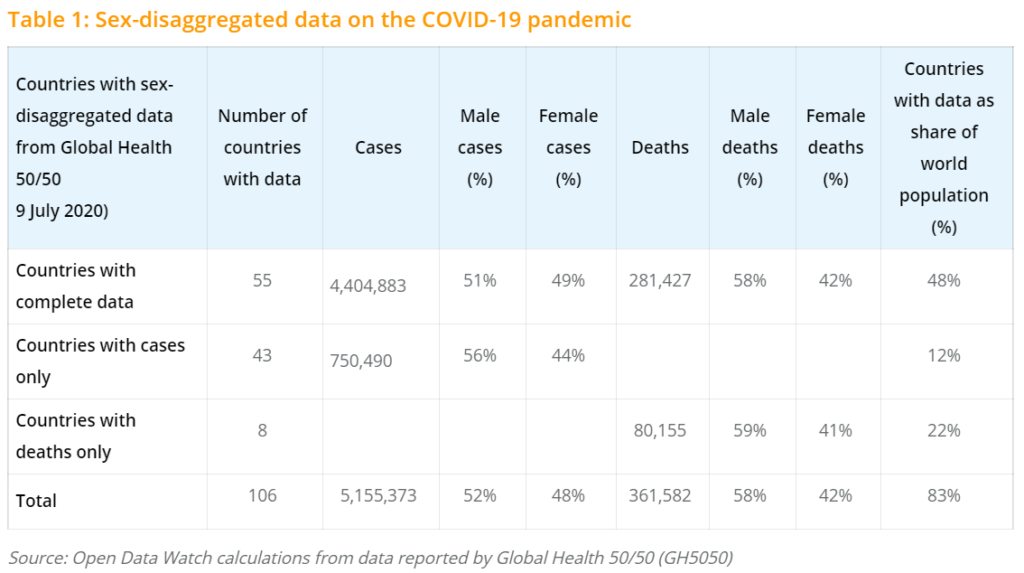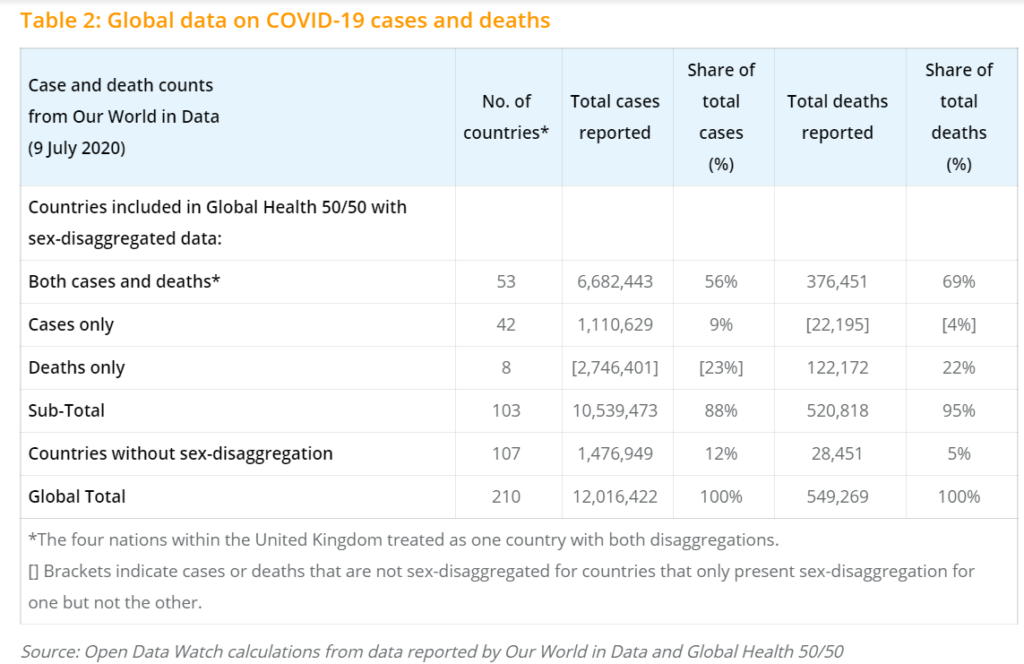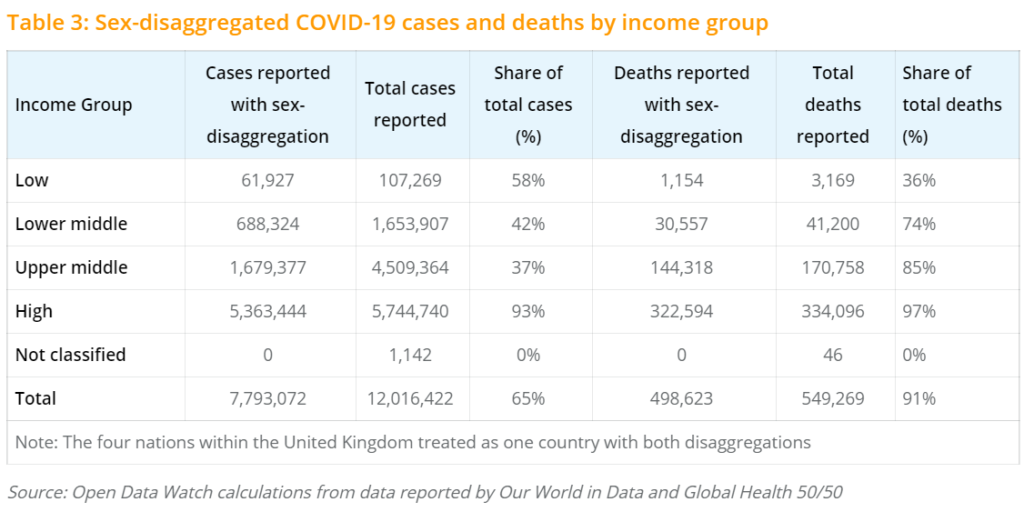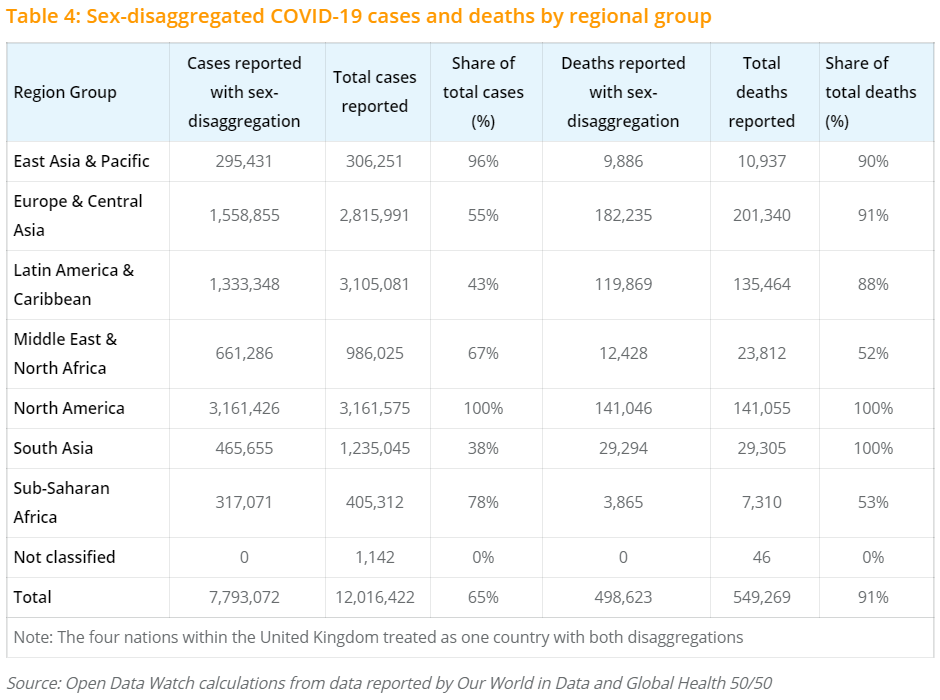This blog series is part of an ongoing study by Data2X and Open Data Watch to track the gender impacts of COVID-19. We recently published a report on the availability of sex-disaggregated data for tracking the primary and secondary impacts of the pandemic. Learn more in our summary blog post and full technical report, Tracking the Gender Impact of COVID-19: An Indicator Framework. This blog post originally appeared on Open Data Watch’s website. Read the first and second blog.
In this third post of our blog series, we summarize the existing data on sex-disaggregated COVID-19 cases and deaths from Global Health 50/50 and ask how complete our picture is when compared to all reported cases and deaths. In addition, we examine the shares of COVID-19 cases and deaths that are sex-disaggregated by income and region. Here are our top five takeaways with a more detailed explanation of each below:
- Four out of five people now live in a country with at least some sex-disaggregated data on COVID-19. For countries with data on cases and deaths, women make up 49 percent of cases but only 42 percent of deaths.
- As of 9 July 2020, 12 low-income countries published sex-disaggregated data. Nearly 3 in 5 cases in low-income countries are now disaggregated by sex, compared to a fourth a month ago. In lower-middle-income countries, meanwhile, sex-disaggregated data are only available for 2 in 5 cases, compared to nearly half last month.
- Low reporting of sex-disaggregated cases in upper-middle-income countries is still driven by the absence of sex-disaggregation of cases by Brazil, with one of the largest caseloads in the world. If Brazil’s 1.7 million cases were sex-disaggregated, the share of cases reported by sex for upper-middle-income countries would double from 37 percent to 75 percent.
- Reporting on deaths by sex reveals the most straightforward correlation between statistical capacity and income. High-income countries report practically all their deaths by sex and this share declines with each step down the income group ladder.
- The capacity to provide sex-disaggregated information on cases and deaths varies widely across regions. East Asia and the Pacific disaggregate virtually all cases and deaths, but many regions struggle with reporting on one or both. Countries in the Middle East and North Africa, for example, provide information on only two-thirds of cases and just over half of deaths, highlighting the need for stronger case reporting and death registration systems.

Table 1 summarizes the sex-disaggregated data available as of 9 July 2020. There were 55 countries reporting sex-disaggregated data for COVID-19 cases and deaths. (These include three nations of the United Kingdom – England, Scotland, and Northern Ireland – that are reported separately. Wales reports cases only.) They represent 48 percent of the world’s population (2019 data). Eight countries report sex-disaggregated data for deaths only. Forty-three more countries report sex-disaggregated data on cases but lack data on deaths. In total, four out of five people now live in a country with at least some sex-disaggregated data on COVID-19. For countries reporting sex-disaggregated data on both cases and deaths, women make up 49 percent of cases but only 42 percent of deaths.
Although stories about reported cases and deaths caused by the COVID-19 virus have mainly covered high-income countries, information about the pandemic in low- and lower-middle-income countries is slowly emerging and will be crucial to monitoring the impacts of the pandemic on development efforts and the 2030 Agenda. As of 9 July 2020, 12 low-income countries published sex-disaggregated data (eight of them for cases only and four, Afghanistan, Burkina Faso, Haiti, and Liberia for both cases and deaths). Sex-disaggregated data is available for 20 lower-middle-income countries.[1] See Table 3 below for a more in-depth discussion on the reporting of deaths and cases by income group.
Table 2 summarizes the number of cases and deaths compiled by the European CDC and reported by Our World in Data (OWID) for the countries with sex-disaggregated data and for the remaining 107 countries that currently lack any sex-disaggregated data.
The countries included in the GH5050 tracker account for 65 percent of global cases and 91 percent of deaths. This global tally reveals that the vast majority of data on deaths are sex-disaggregated, though this may be skewed by most deaths occurring in high-income countries, which have more robust death registration systems. In contrast, only two in three cases are sex-disaggregated, a ratio that would increase to four in five if Brazil reported its cases by sex.

To arrive at a more nuanced understanding of the way in which countries report on COVID-19 cases and deaths, we analyzed the global shares according to World Bank FY2021 income groups in Table 3. Compared to our post last month, the availability of sex-disaggregated case reporting in low-income countries has greatly increased. Forty percent of low-income countries report on cases in GH5050 and they provide sex-disaggregation on nearly 3 in 5 of their cases, compared to a fourth one month ago. On the other hand, the same share of lower-middle-income countries report sex-disaggregated cases, but this accounts for only two in five cases in lower-middle-income countries.
Upper-middle-income countries fare even worse: While about the same share of upper-middle-income countries publish sex-disaggregated data on cases, this accounts for less than forty percent of their cases. This is still driven by the absence of sex-disaggregation of cases by Brazil, with one of the largest caseloads in the world. If Brazil’s 1.7 million cases were sex-disaggregated, the share of cases reported by sex for upper-middle-income countries would double from 37 to 75 percent. The Center for Disease Control recently published long-overdue information on sex-disaggregated cases in the United States, which means the vast majority of cases in high-income-countries are sex-disaggregated. However, the future of U.S. case and death reporting is unclear, due to ongoing restructuring of reporting procedures, which raises the worrying specter of political interference.
Reporting on deaths by sex, meanwhile, reveals the most straightforward correlation between statistical capacity and income. High-income countries report practically all their deaths by sex and this share declines with each step down the income group ladder.

Examining the coverage by region gives further indication where statistical capacity to report needs to be bolstered to tackle the pandemic most effectively. As Table 4 below shows, the capacity to provide sex-disaggregated information varies widely across regions. Virtually all cases in East Asia & Pacific are sex-disaggregated, while just over half are disaggregated in Europe and Central Asia. Sub-Saharan Africa is third among region groups for sex-disaggregated shares of cases, but disaggregates just over half of all deaths, perhaps pointing to issues of death registration systems in these countries. South Asia’s low coverage is explained mainly by India’s lack of reporting on cases, but the region joins North America in reporting all deaths on a sex-disaggregated basis. The Middle East and North Africa have middling disaggregation of cases and, similar to Sub-Saharan Africa, the region needs more robust death registration systems. Latin America, where the pandemic rages most acutely as of the time of this writing, disaggregates less than half of its cases, again owing to the absence of sex-disaggregated case reporting from Brazil. However, its death reporting is in line with the rate of reporting in East Asia & Pacific, as well as Europe & Central Asia.

Next time, the blog will update the global tables above and examine the sex-disaggregated status of information on the health workforce that stands on the frontlines of confronting the pandemic. See you then!
